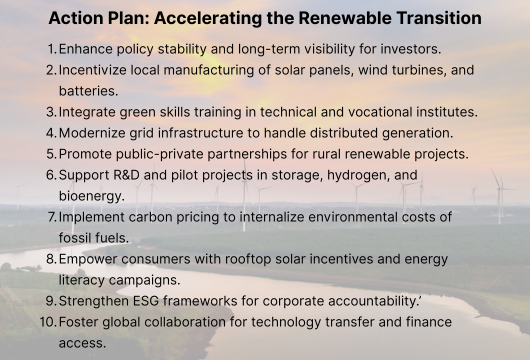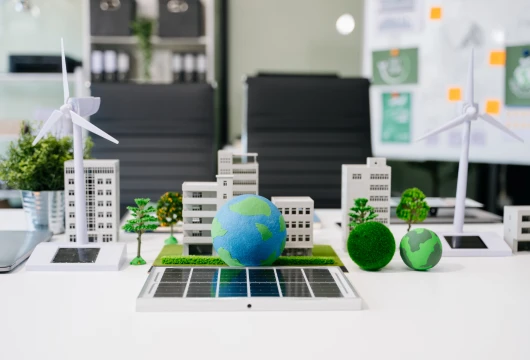Discover how Renewable Revolution fuels growth, resilience, and sustainability for a greener, cleaner future.
Across the world, nations are reimagining their energy future. From the rooftops of rural India to the wind-swept coasts of Scotland, renewable energy is no longer a futuristic concept—it’s today’s reality and tomorrow’s necessity. The transition toward clean, renewable power sources—solar, wind, hydro, biomass, and geothermal—is reshaping the global economy, driving innovation, and redefining the way we think about progress.
In India, this movement is particularly vital. As the world’s third-largest energy consumer, India’s choices today will shape the global energy landscape tomorrow. The country’s ambitious goal of achieving 500 GW of renewable capacity by 2030 and net-zero emissions by 2070 underscores a powerful message: the green transition is not just about environment—it’s about empowerment, inclusion, and economic transformation.
Here are 10 powerful reasons why individuals, businesses, and governments must accelerate their shift to renewable energy.
1️⃣ It’s the Key to Combating Climate Change
Fossil fuels—coal, oil, and gas—are responsible for nearly 75% of global greenhouse gas emissions. Transitioning to renewable energy is the single most effective step toward mitigating climate change. Solar, wind, and hydro power generate electricity without burning carbon-intensive fuels, drastically cutting emissions and air pollutants.
In India, the renewable sector already prevents over 30 million tonnes of CO₂ emissions annually, and this figure is growing fast. A nationwide shift could help meet both domestic climate targets and global commitments under the Paris Agreement.
2️⃣ It Creates Millions of Green Jobs
Renewable energy isn’t just clean—it’s a massive job creator. The International Renewable Energy Agency (IRENA) reports that the renewable sector employed 13.7 million people globally in 2023, a number expected to double by 2030.
India’s renewable sector alone could create over 3 million green jobs by 2030—from solar installation and maintenance to battery manufacturing and R&D. Unlike fossil fuel jobs that concentrate in specific regions, renewable energy employment opportunities are geographically dispersed—bringing prosperity to rural and semi-urban communities.
Example:
In Rajasthan, solar farms have transformed barren land into thriving employment hubs. Villagers trained in solar panel installation now earn steady incomes, showing how the green transition can reduce poverty and migration.
3️⃣ It Strengthens Energy Independence
Energy independence is national security. Countries reliant on imported fossil fuels are vulnerable to global price shocks, supply chain disruptions, and geopolitical conflicts. Renewables, on the other hand, harness local natural resources—sun, wind, water—reducing dependence on volatile global oil markets.
India imports over 80% of its crude oil, straining foreign reserves. Expanding solar and wind capacity can significantly reduce this dependency. The National Hydrogen Mission is another strategic move toward achieving energy self-reliance through green hydrogen.
4️⃣ It Lowers Energy Costs Over Time
One of the biggest myths about renewables is that they’re expensive. In truth, solar and wind power are now the cheapest sources of new electricity in most parts of the world. The cost of solar power has dropped by nearly 90% over the last decade, and wind energy has seen similar declines.
Once infrastructure is built, renewables have near-zero fuel costs and minimal maintenance. For households and industries, this means long-term savings and stable power bills.
Example:
In Gujarat, decentralized rooftop solar programs enable households to save up to 40% on monthly electricity costs. Businesses that adopt solar rooftops achieve faster break-even and insulation from rising grid tariffs.
5️⃣ It Improves Public Health
Air pollution is a silent crisis, causing an estimated 2 million premature deaths annually in India. Burning coal and oil releases pollutants like PM2.5, sulfur dioxide, and nitrogen oxides, leading to respiratory and cardiovascular diseases.
Renewable energy drastically reduces these pollutants. Clean electricity from solar and wind means fewer smog days, healthier lungs, and lower public health expenditure. The World Health Organization links clean energy transitions directly with improved life expectancy and healthcare outcomes.
6️⃣ It Empowers Rural Communities
Renewables are uniquely suited for decentralized power generation, meaning electricity can be produced close to where it’s consumed. This is transformative for rural India, where millions still face unreliable or limited grid access.
Off-grid solar solutions, mini-hydro projects, and biogas plants empower local communities to generate their own energy, run small businesses, irrigate farms, and improve living standards.
Example:
The Saubhagya Scheme and PM-KUSUM Yojana have enabled farmers to use solar pumps, reducing diesel costs and increasing agricultural productivity. Women’s self-help groups are also leading biogas and clean-cookstove enterprises, linking climate action to gender empowerment.
7️⃣ It Drives Innovation and Technological Leadership
Renewable energy fuels the rise of new industries—from smart grids and energy storage to electric mobility and hydrogen technologies. This transition spurs innovation, research, and entrepreneurship.
India’s startup ecosystem is rapidly embracing clean tech. From Bengaluru’s solar analytics platforms to Pune’s battery recycling innovations, green technology startups are scaling globally. Government programs like Startup India and Atal Innovation Mission are boosting R&D in sustainable energy solutions.
As technology advances, renewables are becoming not just cleaner but smarter—integrating AI, IoT, and blockchain for efficiency, transparency, and resilience.
8️⃣ It Attracts Global Investment and Boosts GDP
Sustainability has become a magnet for capital. Global investors are redirecting funds from fossil fuels to green energy, with renewable projects attracting over $500 billion in global investment in 2024 alone.
India’s renewable sector has become a preferred destination for foreign investment, thanks to clear policy signals and improving infrastructure. According to BloombergNEF, India ranked among the top 5 renewable investment destinations globally.
The economic multiplier effect is substantial—new industries, exports, and supply chains emerge around renewables, driving GDP growth and employment simultaneously.
9️⃣ It Enhances Energy Security and Climate Resilience
Extreme weather events—from heatwaves to floods—pose severe threats to centralized fossil fuel infrastructure. Renewable systems, particularly distributed solar and wind, enhance resilience by decentralizing energy production.
Microgrids and hybrid systems can keep critical services—hospitals, schools, emergency operations—running even when main grids fail. In coastal areas prone to cyclones, solar-battery systems have proven lifesaving during disaster recovery.
India’s National Disaster Management Authority and MNRE are already promoting renewable-powered resilience hubs to ensure communities remain energy-secure amid climate crises.
🔟 It Builds a More Equitable and Sustainable Future
The ultimate promise of renewable energy lies in equity. Fossil fuel economies have historically concentrated wealth and power, while renewable systems democratize energy access. Every rooftop, river, and gust of wind becomes a potential power source.
A renewable-driven future fosters inclusive growth, ensuring that rural farmers, urban entrepreneurs, and marginalized groups benefit equally. It aligns with India’s vision of “Sabka Saath, Sabka Vikas”—development for all, with sustainability at the core.
Case Study: India’s Balanced Green Transition
India’s renewable journey demonstrates how economic growth and sustainability can co-exist. With 175 GW of renewable capacity already installed and a strong policy push toward solar parks, green hydrogen, and EVs, the nation is charting a pragmatic yet ambitious path.
The country’s Energy Transition Plan (2023–2030) emphasizes domestic manufacturing, skill creation, and just transition for coal regions—showing that sustainability can also be an engine for socio-economic resilience.
Notable Programs:
- National Solar Mission – Driving large-scale and rooftop solar adoption
- Production Linked Incentive (PLI) Scheme – Supporting domestic solar and battery manufacturing
- Green Hydrogen Mission – Positioning India as a global clean-fuel hub
- EV30@2030 Policy – Targeting 30% electrification of vehicles by 2030
The Global Context: Renewables as a Growth Engine
Globally, the renewable transition is reshaping energy geopolitics:
- China leads in solar PV manufacturing and installation, controlling 80% of the supply chain.
- Europe aims for 45% renewable share by 2030, under the REPowerEU plan.
- The U.S. Inflation Reduction Act (IRA) has turbocharged renewable investment with $370 billion in green incentives.
- Africa and Southeast Asia are tapping into solar microgrids to leapfrog fossil fuel dependence.
These developments show that renewables are no longer an environmental choice—they’re an economic inevitability.
Barriers to Overcome
Despite clear advantages, several challenges persist:
- Storage & Intermittency: Solar and wind require better energy storage systems.
- Financing Gaps: Upfront investment costs remain high for small developers.
- Policy Consistency: Frequent regulatory changes can deter private investment.
- Grid Infrastructure: Need for modern, flexible grids to integrate renewables effectively.
- Public Awareness: Consumer education is vital for widespread adoption.
The good news? Each of these challenges is an opportunity for innovation, collaboration, and capacity building.

The Power of Choosing Renewables
The shift to renewable energy isn’t merely about cleaner air or cheaper electricity—it’s about redefining the future of human progress. Every solar panel installed, every wind turbine erected, and every community electrified brings us closer to a just, resilient, and sustainable world.
For India, this shift holds transformative power—creating millions of jobs, boosting self-reliance, and driving innovation across every sector of the economy. The renewable revolution is no longer optional; it’s inevitable.
The question is not if we’ll switch to renewables—but how fast we’ll make it happen.
Let’s make that shift, together.
For more inspiring Blogs, click here

